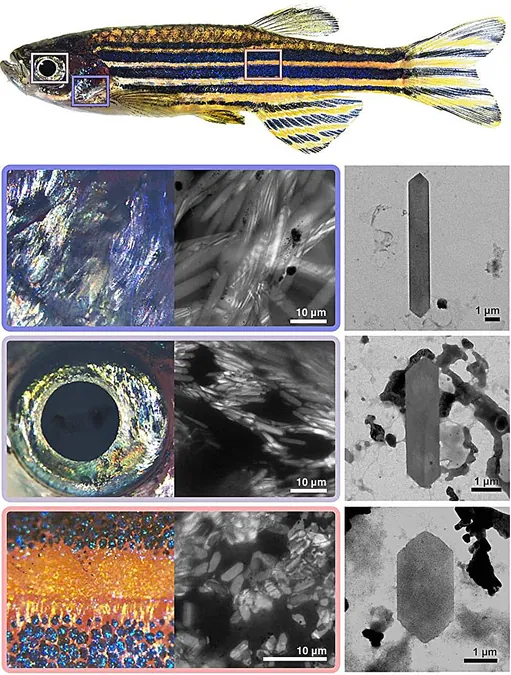
The Surprising Secret Behind Nature's Colorful Animal Crystals Exposed!
2024-09-23
Introduction
What do fish, chameleons, crabs, and the infamous chemistry teacher Walter White from "Breaking Bad" have in common? Surprisingly, they all have a knack for creating crystals! While the latter may have used his skills for nefarious means, the former group relies on these gorgeous natural crystals for more constructive purposes, including vision, camouflage, heat regulation, and even communication.
Key Molecules Involved
At the heart of this fascinating phenomenon are two simple molecules—guanine and hypoxanthine. Despite their basic composition, animals showcase an astonishing array of crystal shapes, uses, and optical properties, sparking curiosity among researchers. However, until recently, the biological processes behind this diverse crystal formation remained a mystery.
Groundbreaking Research
A groundbreaking study from the Weizmann Institute of Science, published in *Nature Chemical Biology*, finally sheds light on these "biological recipes" responsible for the creation of such an extensive variety of crystals. Highlighting the zebrafish as a primary example, researchers discovered the myriad of colors and shapes in its tissues, from the shiny operculum covering its gills to the bluish reflections of its eyes and the yellowish hues of its skin cells.
Crystal Analysis
Dr. Dvir Gur and his research team isolated these crystals and used electron microscopy to examine their unique shapes and arrangements. They found that the gill crystals were long and narrow, while those in the eyes took on a shorter form, and skin crystals were even smaller. This rich diversity served as a perfect opportunity to study how crystal properties are biochemically and genetically managed, without the complications of comparing crystals from different species.
Influence of Molecular Ratios
The researchers observed that the shape of the crystals is influenced by the ratio of guanine to hypoxanthine—akin to a baker adjusting ingredient proportions to craft various pastries. By experimenting with these ratios in the lab, they successfully replicated three distinct types of zebrafish crystals, each with unique characteristics based on their molecular compositions.
Biological Importance of Crystals
Beyond their ornamental value, guanine and hypoxanthine play vital roles in all life forms, contributing crucially to DNA construction and cellular functionality. To delve deeper, Ph.D. student Rachel Deis and her team isolated specialized crystal-producing cells known as iridophores. They explored the biological mechanisms that enable these cells to create tailored crystals, revealing an unexpected balance of enzymes at play.
Enzyme Behavior in Iridophores
Surprisingly, iridophores contained high levels of crystal-forming enzymes but exhibited lower levels of competing enzymes. This peculiar balance may dictate the ratio of crystal-building blocks, impacting the resulting crystal forms and their functions. For comparison, humans have only one enzyme responsible for guanine synthesis, while zebrafish possess five, allowing them to synthesize various guanine and hypoxanthine ratios without disrupting cellular processes.
Testing the Hypothesis
To test this theory, researchers engineered zebrafish that could not produce one specific enzyme, pnp4a, essential for crystalline guanine production. The alteration resulted in diminished crystal numbers in the fish's eyes and unexpected shape changes. This confirmed that the delicate balance of enzymes in each cell group plays a crucial role in determining crystal structure.
Conclusion and Future Directions
In a stunning culmination of their research, the team has unveiled the entire mechanism from gene expression through enzyme activity to the formation of distinct crystal characteristics. Their interdisciplinary approach—merging biology with optics and biomaterials—has not only deepened our understanding of nature’s creativity but also opened the door to mimicking these intricate materials in future technologies.
Final Thoughts
Stay tuned as we continue to uncover the secrets of nature's genius and explore the wonders that can arise from simple molecular structures.




 Brasil (PT)
Brasil (PT)
 Canada (EN)
Canada (EN)
 Chile (ES)
Chile (ES)
 España (ES)
España (ES)
 France (FR)
France (FR)
 Hong Kong (EN)
Hong Kong (EN)
 Italia (IT)
Italia (IT)
 日本 (JA)
日本 (JA)
 Magyarország (HU)
Magyarország (HU)
 Norge (NO)
Norge (NO)
 Polska (PL)
Polska (PL)
 Schweiz (DE)
Schweiz (DE)
 Singapore (EN)
Singapore (EN)
 Sverige (SV)
Sverige (SV)
 Suomi (FI)
Suomi (FI)
 Türkiye (TR)
Türkiye (TR)